
Silverstoneia flotator, the rainforest rocket frog, is a terrestrial, diurnal frog found in humid lowlands of Costa Rica and Panama. It is considered to be of least concern by the IUCN. The taxonomy is in need of a review, as it may consist of a complex of several species.

Cochranella euknemos, sometimes known as the San Jose Cochran frog, is a species of frog in the family Centrolenidae. It is found in central Costa Rica and south/eastward to Panama and to the western flank of the Cordillera Occidental in Colombia. Some Colombian records might apply to Cochranella mache.
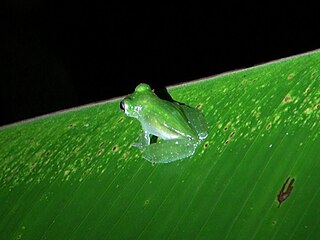
Hyalinobatrachium valerioi, sometimes known as the La Palma glass frog, is a species of frog in the family Centrolenidae. It is found in central Costa Rica and south to Panama and the Pacific lowlands and slopes of western Colombia and Ecuador; also in the Magdalena River Valley of Colombia.
Silverstoneia erasmios is a species of frog in the family Dendrobatidae. It is endemic to Colombia where it is known from the Cordillera Occidental and Cordillera Central in the Antioquia Department.
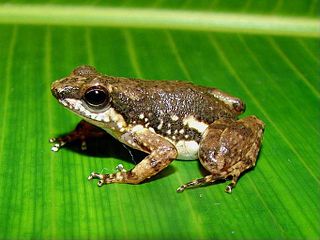
Colostethus inguinalis is a species of frog in the family Dendrobatidae. It is endemic to northwestern and northcentral Colombia. Its vernacular name is common rocket frog, although this name can also refer to Colostethus panamansis that until 2004 was considered a junior synonym of Colostethus inguinalis. Much of the older literature on Colostethus inguinalis is actually about Colostethus panamansis.

Colostethus panamansis, also known as the Panama rocket frog or (ambiguously) common rocket frog, is a species of poison dart frog. It is found in northwestern Colombia and Panama. It is one of the best studied poison dart frogs; however, until 2004 Colostethus panamansis was considered a synonym of Colostethus inguinalis, and consequently the older literature uses that name.

The granular poison frog or granular poison arrow frog is a species of frog in the family Dendrobatidae, found in Costa Rica and Panama. Originally described as Dendrobates granuliferus, it was moved to Oophaga in 1994. Its natural habitats are tropical humid lowland forests; it is threatened by habitat loss.
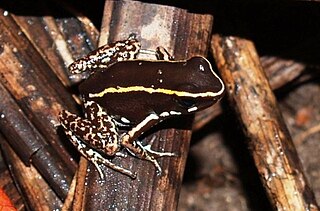
The lovely poison frog or lovely poison-arrow frog is a species of frog in the family Dendrobatidae. It is found on the Caribbean versant of Central America from southeastern Nicaragua through Costa Rica to northwestern Panama, with one record just west of the Panama Canal. Populations from the Pacific versant, formerly included in this species, are now identified as Phyllobates vittatus.
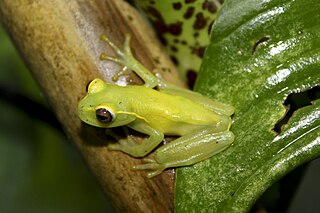
The La Loma tree frog is a species of frog in the family Hylidae found in Costa Rica, Panama, and expected but not confirmed in Colombia. Its natural habitats are tropical moist lowland and montane forests, with breeding taking place in streams. It is threatened by habitat loss and chytridiomycosis.

The Panama cross-banded tree frog or pug-nosed tree frog is a species of frog in the family Hylidae found in the humid Pacific lowlands of southwestern Costa Rica to eastern Panama and in the Caribbean lowlands of Panama and northern Colombia. Males of the species utilize synchronous calling to hide their position from predators. Females create basins during amplexus and deposit fertilized eggs onto the surface of the water.
Craugastor andi is a species of rain frog in the family Craugastoridae which has not been seen since 1990. It is found in the Caribbean drainage of Costa Rica in the mountains and hills of the Cordillera Central and the far northeastern Cordillera de Talamanca, and in extreme northwestern Panama. Frank and Ramus (1995) give it the vernacular name Atlantic robber frog. It is known locally in Spanish by the generic names, used for many species, of rana de hojarasca, ranita or sapito.

Strabomantis bufoniformis is a species of frog in the family Strabomantidae. It is found in western Colombia, Panama, and south-eastern Costa Rica. It is sometimes known as the rusty robber frog.

Craugastor taurus is a species of frog in the family Craugastoridae. It is found in the Golfo Dulce region of southern Costa Rica and adjacent western Panama. It is sometimes known as the Golfito robber frog.
Pristimantis altae, also known as mountain robber frog, is a species of rain frog in the family Strabomantidae with a bright coral-coloured groin. It is found in Costa Rica and Panama.
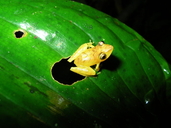
Pristimantis caryophyllaceus is a species of frog in the family Strabomantidae. It is found in Costa Rica and Panama; records from Colombia prior to 2010 refer to Pristimantis educatoris. However, taxonomy of Pristimantis caryophyllaceus and P. educatoris remain unsettled, and many sources continue to report Pristimantis caryophyllaceus from Colombia.
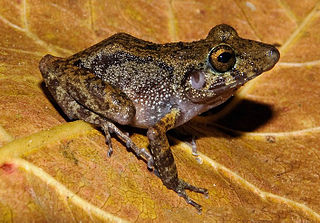
Pristimantis gaigei, also known as the Fort Randolph robber frog or Gaige's rain frog, is a species of frog in the family Strabomantidae. It is found in the Atlantic drainage lowlands from extreme south-eastern Costa Rica to eastern Panama and to central Colombia; it is widely distributed in Colombia west of the Cordillera Oriental. Its natural habitat is primary humid lowland forest, but it also occurs in secondary forest. It is a nocturnal species found under surface debris and in leaf-litter.
Lithobates vibicarius, commonly known as either green-eyed frog or Rancho Redondo frog, is a species of frog in the family Ranidae from highland rainforests in Costa Rica and western Panama.
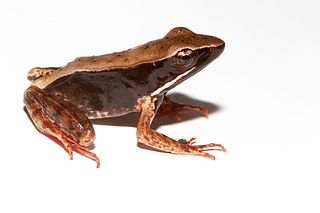
Warszewitsch's frog is a species of frog in the family Ranidae found in Honduras, Nicaragua, Costa Rica, and Panama.

Silverstoneia is a genus of poison dart frogs from southern Central America and northern South America, between southwestern Costa Rica and southwestern Colombia. It is named in honour of Phillip A. Silverstone, an expert on dendrobatoid frogs.
Silverstoneia punctiventris is a species of frog in the family Dendrobatidae. It is endemic to Colombia's Chocó region.














